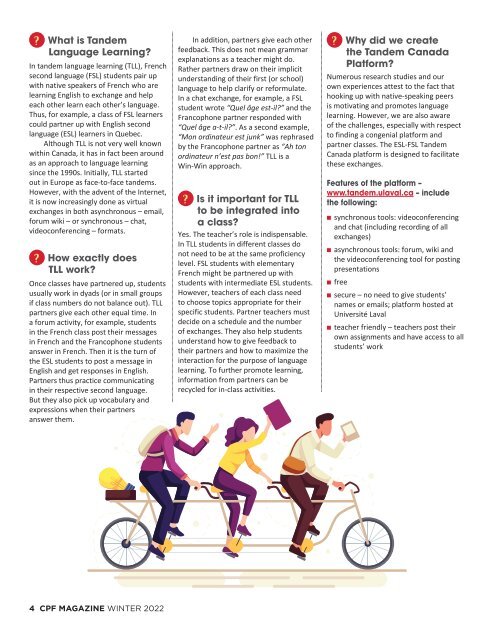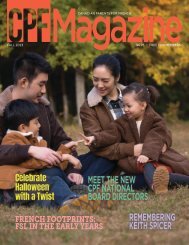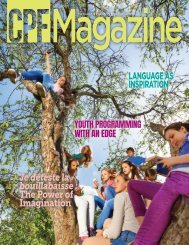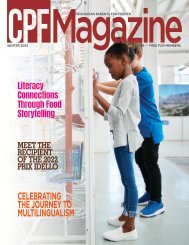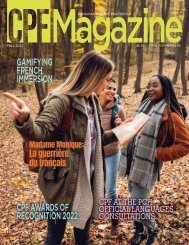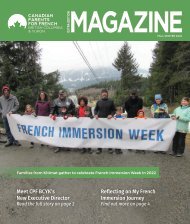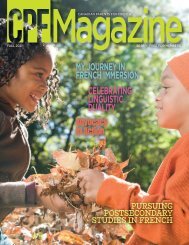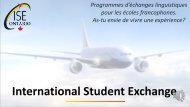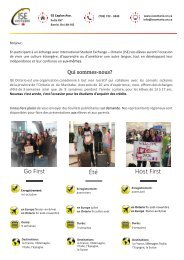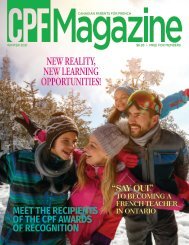CPF Magazine Winter 2022 Issue
A national network of volunteers, parents and stakeholders who value French as an integral part of Canada. CPF Magazine is dedicated to the promotion and creation of French-second-language learning opportunities for young Canadians.
A national network of volunteers, parents and stakeholders who value French as an integral part of Canada. CPF Magazine is dedicated to the promotion and creation of French-second-language learning opportunities for young Canadians.
You also want an ePaper? Increase the reach of your titles
YUMPU automatically turns print PDFs into web optimized ePapers that Google loves.
?<br />
What is Tandem<br />
Language Learning?<br />
In tandem language learning (TLL), French<br />
second language (FSL) students pair up<br />
with native speakers of French who are<br />
learning English to exchange and help<br />
each other learn each other’s language.<br />
Thus, for example, a class of FSL learners<br />
could partner up with English second<br />
language (ESL) learners in Quebec.<br />
Although TLL is not very well known<br />
within Canada, it has in fact been around<br />
as an approach to language learning<br />
since the 1990s. Initially, TLL started<br />
out in Europe as face-to-face tandems.<br />
However, with the advent of the Internet,<br />
it is now increasingly done as virtual<br />
exchanges in both asynchronous – email,<br />
forum wiki – or synchronous – chat,<br />
videoconferencing – formats.<br />
?<br />
How exactly does<br />
TLL work?<br />
Once classes have partnered up, students<br />
usually work in dyads (or in small groups<br />
if class numbers do not balance out). TLL<br />
partners give each other equal time. In<br />
a forum activity, for example, students<br />
in the French class post their messages<br />
in French and the Francophone students<br />
answer in French. Then it is the turn of<br />
the ESL students to post a message in<br />
English and get responses in English.<br />
Partners thus practice communicating<br />
in their respective second language.<br />
But they also pick up vocabulary and<br />
expressions when their partners<br />
answer them.<br />
In addition, partners give each other<br />
feedback. This does not mean grammar<br />
explanations as a teacher might do.<br />
Rather partners draw on their implicit<br />
understanding of their first (or school)<br />
language to help clarify or reformulate.<br />
In a chat exchange, for example, a FSL<br />
student wrote “Quel âge est-il?” and the<br />
Francophone partner responded with<br />
“Quel âge a-t-il?”. As a second example,<br />
“Mon ordinateur est junk” was rephrased<br />
by the Francophone partner as “Ah ton<br />
ordinateur n’est pas bon!” TLL is a<br />
Win-Win approach.<br />
?<br />
Is it important for TLL<br />
to be integrated into<br />
a class?<br />
Yes. The teacher’s role is indispensable.<br />
In TLL students in different classes do<br />
not need to be at the same proficiency<br />
level. FSL students with elementary<br />
French might be partnered up with<br />
students with intermediate ESL students.<br />
However, teachers of each class need<br />
to choose topics appropriate for their<br />
specific students. Partner teachers must<br />
decide on a schedule and the number<br />
of exchanges. They also help students<br />
understand how to give feedback to<br />
their partners and how to maximize the<br />
interaction for the purpose of language<br />
learning. To further promote learning,<br />
information from partners can be<br />
recycled for in-class activities.<br />
?<br />
Numerous research studies and our<br />
own experiences attest to the fact that<br />
hooking up with native-speaking peers<br />
is motivating and promotes language<br />
learning. However, we are also aware<br />
of the challenges, especially with respect<br />
to finding a congenial platform and<br />
partner classes. The ESL-FSL Tandem<br />
Canada platform is designed to facilitate<br />
these exchanges.<br />
Features of the platform –<br />
www.tandem.ulaval.ca – include<br />
the following:<br />
n synchronous tools: videoconferencing<br />
and chat (including recording of all<br />
exchanges)<br />
n asynchronous tools: forum, wiki and<br />
the videoconferencing tool for posting<br />
presentations<br />
n free<br />
Why did we create<br />
the Tandem Canada<br />
Platform?<br />
n secure – no need to give students’<br />
names or emails; platform hosted at<br />
Université Laval<br />
n teacher friendly – teachers post their<br />
own assignments and have access to all<br />
students’ work<br />
4 <strong>CPF</strong> MAGAZINE WINTER <strong>2022</strong>


